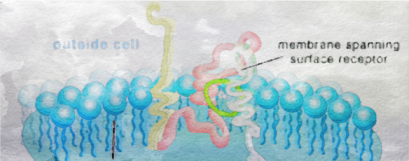Cell Surface Receptors


Cell Surface Receptors included 3 classes: ion channel-linked receptors, enzyme-linked receptors, and G protein-coupled receptors.
Ion channels are pore-forming proteins present in the membranes of all cells. Ions pass through channels down their electrochemical gradient, without the requirement for ATP or metabolic energy. Ion channels act through synaptic signaling to convert chemical signals (ligand) to electrical ones.
Enzyme-linked receptors are usually single-pass transmembrane receptors. This group includes the receptor tyrosine kinases (RTKs), receptor serine/threonine kinases, receptor-like tyrosine phosphatases, and receptor guanylyl cyclases
G-protein-coupled receptors (GPCRs), also known as 7 transmembrane (7-TM) receptors, are structurally and functionally related proteins characterized by seven membrane-spanning a helices. G protein–coupled receptors are found only in eukaryotes. G protein–coupled receptors are involved in two signal transduction pathways , the cAMP signal pathway and the phosphatidylinositol signal pathway.
The ligands that bind and activate these receptors include light-sensitive small molecule compounds, pheromones, hormones, and neurotransmitters. G protein–coupled receptors are involved in many diseases and consist of 40% drug targets. ,
References:
- Overington, J.P., et al., Nat. Rev. Drug Disc. 2006; 5: 993-996.
- Sallman, M. et al., BMC Biol. 2009; 7: 50.
-
http://en.wikipedia.org/wiki/G_protein–coupled_receptor